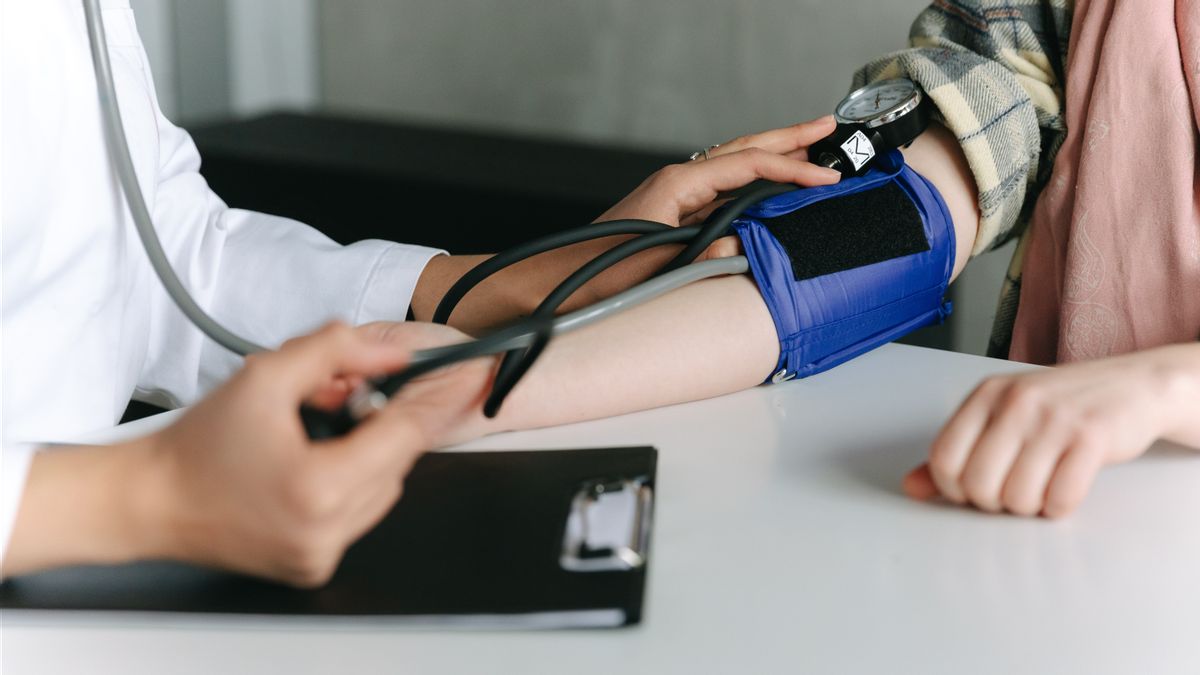JAKARTA - Hypertension can cause blood clots of the brain to harden and blood flow to the brain is hampered, triggering a stroke, ranging from mild to severe scale and even life threatening if not treated immediately.
Facilities Specialist at the National Heart Center Hospital Harmeiwaty, Sp.S, said that hypertension is the main risk factor of a stroke.
"If the clogged arteries are in the brain, this will prevent the brain from getting enough blood flow and oxygen, so that the longer more cells or brain tissue will die," said dr. Eka was quoted as saying by ANTARA, Saturday, September 3.
Each increase in systolic blood pressure by 2 mmHg increases the risk of a 10 percent stroke in adults. Hypertension itself was found at 64-70 percent of stroke cases.
Mechanically, high blood pressure basically causes damage to the walls of the blood vessels and interferes with the function of the muscles in the walls of the arteries' blood vessels. This condition can make the arteries stiff and clogged.
Furthermore, dr. Eka said this can put a person at a much higher risk of stroke.
Damage to endotel or blood vessel wall cells and arterial muscle layers due to hypertension can also cause depletion of the blood vessel wall in the brain so that it can cause arteries to break easily and cause bleeding in the brain.
Hypertension itself is a chronic disease that cannot be cured. If a person's blood pressure has reached the target, it does not mean that he is cured, but controlled.
"If it is controlled, it is hoped that it can avoid complications, one of which is brain damage such as a stroke," said dr. Eka.
However, dr. Eka said many people did not know that he had suffered high blood pressure because there were often no symptoms.
Often a person has a stroke suddenly due to hypertension, but the patient never knows that he has hypertension. stroke itself is the second cause of death and the third cause of disability in the world.
In 2021, globally, it is estimated that 1 in 4 adults over the age of 25 had experienced a stroke. It is estimated that 13.7 million people in the world experienced the first stroke that year and more than 5.5 million died.
In terms of economic burdens for Indonesia, Hypertension is a catalyst disease and absorbs a fairly large BPJS budget. According to BPJS data, 2016's Hypertension financing almost doubled compared to the previous 2 years.
According to BPJS Kesehatan, stroke is one of the highest costs, reaching IDR 2.56 trillion in 2018. This is why Stroke needs to be taken seriously.
The earliest step to prevent stroke is to control blood pressure. In addition to primary stroke prevention, blood pressure reduction is also important to prevent the recurrence of the disease.
The decrease in the 10 mmHg systolic pressure will lower the risk of stroke by up to 27 percent and the high pressure reduction in the blood pressure linear will reduce the risk of recurring strokes.
dr. Eka explained that the first thing to pay attention to in preventing hypertension is recognizing risk factors that can cause hypertension itself, such as age, obesity, foods that contain too much salt and a little potassium, lack of exercise, smoking and alcohol consumption, to stress.
"The risk factor is able to make blood pressure unstable. Currently, there are two additional risk factors that also need to be considered, such as cold air and air pollution," said dr. Eka.
Hypertension tends to be higher when the air is cold. This is because low temperatures can make blood vessels narrow temporarily.
This condition is able to increase blood pressure because more pressure will be needed to force blood through blood vessels through narrowing arteries.
As for pollution, many studies show that in addition to causing hypertension, air pollution also increases the risk of stroke. The incident is related to the length of exposure, age, and the risk of cardiovascular disease such as diabetes.
Emissions from motorized vehicles are the main cause (more than 90 percent) of air pollution in urban areas.
A study in 2020 showed meaningfully that long-term exposure to PM2.5 (particylics/small particles of air pollution) would increase the risk of ischemic strokes and bleeding strokes.
In addition, several lifestyles for urban people are also able to trigger hypertension such as unhealthy diets and tend to have a medium lifestyle. This lifestyle can increase the risk of hypertension, which is a factor that causes stroke.
The public is advised to recognize and control blood pressure themselves to avoid unwanted diseases.
One form of blood pressure control is to diligently measure your own blood pressure with home blood pressure monitoring (HBPM).
"Patients with hypertension must continue to comply in undergoing proper and periodic treatment and blood pressure measurement. Stroke patients must also manage their hypertension properly so as not to get worse and result in permanent or death defects," said dr. Eka.
The English, Chinese, Japanese, Arabic, and French versions are automatically generated by the AI. So there may still be inaccuracies in translating, please always see Indonesian as our main language. (system supported by DigitalSiber.id)













